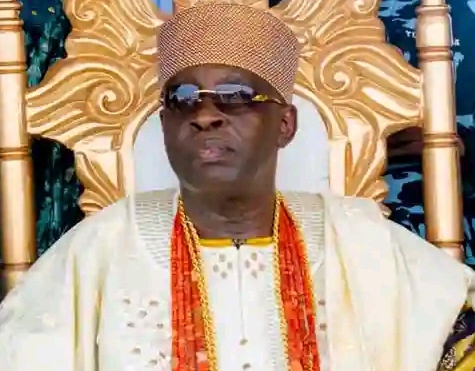In this feature, the editor, FEMI OGUNLANA & TAIWO AYOOLA delve into the mysterious world of a masquerade (egungun) in Ogbomoso, Danafojura, which drenches itself in fire and so must not see another fire.
The legends of Danafojura are as fascinating as frightening. Danafojura ranks among the top, powerful egunguns (masquerades) in Ogbomoso and environs. Its adherents claim the masquerade is unrivalled in terms of accumulation and dispensation of charms that is the hallmark of masquerades. The current Danafojura masquerader, Chief Sunday Abioye Olalere Babatunde in a chat with The Insight before he went under the regalia the last time it was on parade, Thursday, July 25, 2019, in fact notes that Danafojura is not an aggressive egungun but that no other egungun ought to come face-to-face with it because of the dire consequences awaiting whichever egungun dares it. Danafojura is no doubt one of the egunguns that draw a large ecstatic crowd surging behind it to behold its displays especially the burning regalia when lit.
Danafojura, whose other name is Eegun Alakasu belongs to the Alakasu Abonde family in Alakasu Area of Ogbomoso and comes out every other year, “It is too powerful and involves so elaborate preparations to come out yearly,” it is claimed. Its masquerader adds, “It is not an egungun that should come out every year because the things associated with it is enormous. That is why it is not a yearly masquerade.”

Alakasu is a name derived from akasu oogun (ball of charms), The Insight learnt after inquiring from a woman in the family. “The family’s name is akasu oogun, that is the reason the family is called Alakasu, and it is by that name the area is known today,” the elderly woman said.
Many are the legends of this egungun but basically, according to Chief Sunday Babatunde, the masquerader, it is an egungun that prays for the people, for the town and for the country. Truly, on the day it came out, many people knelt and bowed before him and he blessed them.
Its unique feature however is the fire with which it is known and associated and from which it derived its more popular name – Danafojura. The moment this powerful egungun steps out of its lair, it is swallowed in fire as dried spear grasses (eekan) are put on it and lit. The egungun then bursts into the road intermittently cringing in guttural voice with the shout of cold, cold (otutu), which attracts more of the dry spear grasses and fire. Asked who actually suffers the cold, whether the masquerader or the masquerade, Chief Babatunde only retorts, “We don’t understand the journey. It is what we inherited from our forebears, as it cries of cold, they put more fire on it to ease its discomfort.”
More frightening is that this egungun cannot stand seeing another burning fire, so at its approach, women and all those cooking quickly put out the fire and cover every trace of it. If dared, this egungun will straightaway dip either its hand or leg in what is being cooked or fried, and whatever it is – oil being used for frying, hot pap, amala or whatever will turn black.
“Yes, that power still remains. The reason is that this egungun must not see another fire. The amala (yam flour) sellers, the elekos (hot pap sellers), akara (bean cake) sellers, whoever is cooking and this egungun is coming they must put out the fire or else if it gets there and it thrusts its hand or leg inside what is on fire, it turns black,” Danafojura masquerader submits.
Among the preparations that precede its coming out according to investigations is the soaking of the egungun’s regalia in concoction (agbo) seven days earlier. Several other sacrifices are offered, “We make many sacrifices which we can’t reveal here however,” Chief Babatunde stated. That morning meanwhile before he puts on the regalia, he is half naked – he is clean shaved, he puts on no clothes in the upper body (in fact this interview was conducted at this time). Then, the masquerader beats a bell circling the main family compound, chanting some incantations. At the wee hour, he disappears into the house, the doors to the two entrances are locked and women are made to vacate all the rooms.

Its drummers
The Insight did not witness what went on inside however because non-family members are not allowed inside at the final hours before the masquerade ventures out. In fact, the doors will remain locked till the return of the masquerade late evening and none of the women must go inside.
Behind the house was observed three strange objects aligned in a straight line. Burning firewood, then two pestles buried apart, one bearing traditional pot containing oil and burning wick and the other a needle holding bitter kola (an insignia of Sango deity). Upon inquiry, The Insight learned it is to prevent rain along the path of the masquerade till it returns. At exactly 9: 25am the egungun bursts out into the midst of milling expectant crowd. Its coming out is preceded by four young boys each carrying a brownish dark staff which it was learnt must not touch anyone. Drummers who have been giving off the masquerade’s tunes – Alakasu lo go ru 2x, Igi Ola 2x, Iji mo wo 2x, Ese ola 2x … ko sewu loko afi giri aparo etc – increased the tempo as it steps out grandly. Its adherents put dry leaves on it and lit the fire. It swayed forward and backward dancing to the drum beat, swollen headed at the recitation of its cognomen. Some old women continually sing its cognomen.
People surged forward to catch a glimpse but at the same time beating a swift retreat at its approach fearing what could be the consequence if they rush into him. The masquerade swayed to the drumming holding three objects; a small broom, a hoe handle and a staff, all wearing the brownish dark colour of its regalia. Certain ceremonies were performed before hitting the street running, such as paying homage at the shrine of the Satan and other shrines in the sprawling compound, where it prays fervently. It subsequently dashes into the several Alakasu compounds in the vicinity to bless the occupants. Fire is lit on it on the road in front of one of the buildings and the weary journey began.
The trajectory of Egunguns’ outing basically involves paying visits to homes of their family members and friends; dance displays, heaping blessings on their hosts and are in turn appreciated with hot drinks and money. Surprisingly, the movement of Danafojura was fast, it dashed forward hither thither, swaying to the rhythm of the drumming, and in fact, you have to be in good physical condition to be able to keep abreast of its movement.
Danafojura would later pay visit to the palace of Aare Alasa though the latter was not at home, and from Alasa’s palace the train trudged to Oja-Ajagun to await the invitation of the Soun of Ogbomoso, Oba Oladunni Oyewumi Ajagungbade III JP CON CFR to pay homage.
Later in the evening the egungun entered the palace via the Abata section (resting place of past Souns). The Soun was already seated in his majesty on his throne at the pavilion. The egungun subsequently performed for Kabiyesi, showing off its fire mastery power to the admiration of all. The palace ceremony also featured blessings for Soun and Ogbomoso in general just as Soun saluted the egungun and presented it a bottle of Schnapp and cash.

Women praise singing the masquerade
Chief Babatunde, who became Danafojura’s masquerader in 2007, after there had been an interregnum, further informed that there was a version of Danafojura in Oke-Ogun area. According to him, the man that started it in Oke-Ogun was once accommodated at Alakasu compound disclosing his forebears subsequently initiated him into the Danafojura mystery.
He also said that Danafojura is one of those strong masquerades brought home from warfronts but when asked about the mystery of bringing egunguns from warfronts he said it was beyond his comprehension that it was something only their forefathers understood. How does Danafojura react to insolent egunguns? He was asked. His response: “If we encounter such, it is our forefathers that know what to do to such an egungun, so, if we encounter it, we will not say anything but whatever consequences come upon such egungun, it will have to bear it.”
His journey into the world of egungun which started in 2007 he revealed was because he was chosen by Ifa to assume the task. “The former masquerader after he died, there was no one to continue as the masquerader. Thereafter, calamities began to befall the family, we asked Ifa and it stated that it was because of the egungun we abandoned in the family. The antidote was that we should resurrect it. It was Ifa that chose me to be the masquerader eventually.”
He stressed finally when asked, that he had stopped going to church following his initiation into the mystery of egungun deity.
In the wake of its appearance in 2019, it will be in 2021 that it will venture out again.

